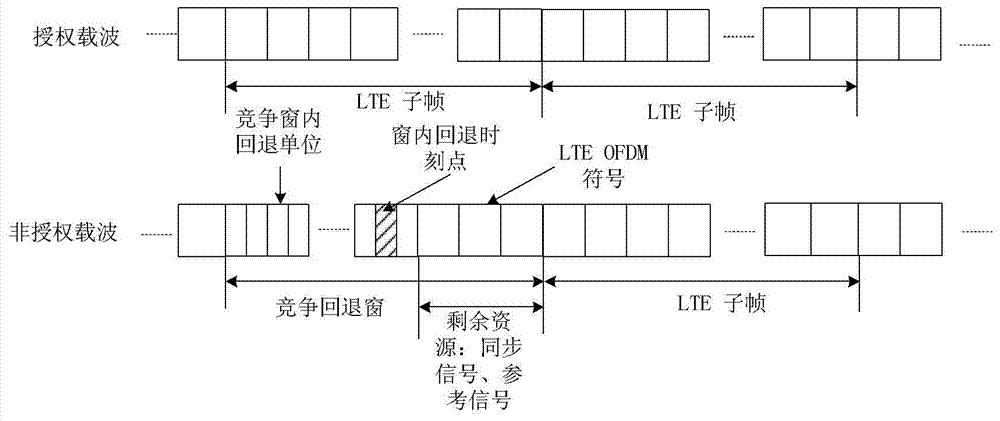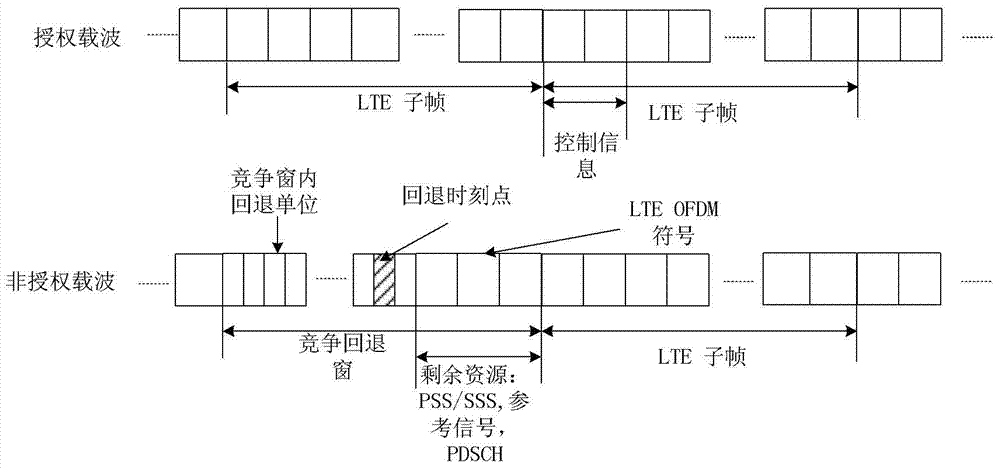Method and base station for transmitting and receiving signals by using unauthorized carrier waves and user equipment
A signal sending and unauthorized technology, applied in the field of communication, can solve problems such as difficult coordination, many wireless access sites, and large number of users
- Summary
- Abstract
- Description
- Claims
- Application Information
AI Technical Summary
Problems solved by technology
Method used
Image
Examples
Embodiment 1
[0236] Step 1: The base station selects a relatively idle unlicensed carrier as a candidate preemptive unlicensed carrier through a measurement or carrier selection mechanism.
[0237] If the base station has selected a preempted unlicensed carrier, the base station can notify the UE of the frequency point, bandwidth and other information of the unlicensed carrier through the licensed carrier (if the bandwidth is fixed, there is no need to notify). Because there are many unlicensed carriers available for access in the unlicensed frequency band, notifying the frequency point information of the unlicensed carriers to the subordinate UE can prevent the UE from simultaneously receiving or blindly detecting data in multiple candidate unlicensed carriers . This information can be transmitted to the UE when the RRC connection is established. Both the base station and the UE will think that the base station passes the UE's unlicensed carrier frequency point, and the UE will use it as...
Embodiment 2
[0248] The solution of Embodiment 2 is similar to that of Embodiment 1, except that in Embodiment 2, the unlicensed carrier information sent by the base station to the UE does not include the fallback time point within the contention window.
[0249] refer to figure 2 In Embodiment 2, after the base station competes for an unlicensed carrier, the signal sent to the UE also includes service data signals, such as PDSCH, and the rest of the transmitted signals are the same as in Embodiment 1. Further, the base station and the UE agree that the base station will send the PSS in the first LTE OFDM symbol and send the SSS in the second LTE OFDM symbol after preempting the unlicensed carrier. Alternatively, an exchange method can also be used. For example, the base station and the UE agree that the base station will send the SSS in the first LTE OFDM symbol and the PSS in the second LTE OFDM symbol after preempting the unlicensed carrier. When LTE PSS / SSS is supported, it will affe...
Embodiment 3
[0254] In Embodiments 1 and 2, the subframes of the unlicensed carrier and the licensed carrier are aligned, and the base station discharges OFDM symbols used to send signals according to the OFDM symbol duration to the backoff time in the contention backoff window from the beginning of the next subframe. However, in Embodiment 3, after the base station competes for an unlicensed carrier, that is, when the base station arrives at a fallback time point within its own contention window, the listening carrier is always idle, and the base station directly takes this time point as the start of the subframe time, subframes are divided backwards according to the subframe duration of LTE (such as image 3 shown), and transmit signals in the divided subframes.
[0255] On the UE side, it is still necessary to blindly detect the signal sent by the base station to determine whether the base station has obtained the right to use an unlicensed carrier. Alternatively, the UE may also judge...
PUM
 Login to View More
Login to View More Abstract
Description
Claims
Application Information
 Login to View More
Login to View More - R&D
- Intellectual Property
- Life Sciences
- Materials
- Tech Scout
- Unparalleled Data Quality
- Higher Quality Content
- 60% Fewer Hallucinations
Browse by: Latest US Patents, China's latest patents, Technical Efficacy Thesaurus, Application Domain, Technology Topic, Popular Technical Reports.
© 2025 PatSnap. All rights reserved.Legal|Privacy policy|Modern Slavery Act Transparency Statement|Sitemap|About US| Contact US: help@patsnap.com



